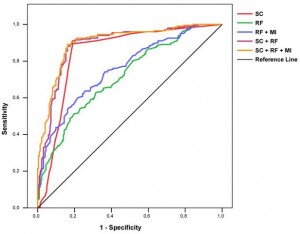Correlations/Regressions of ECG Data and Weights From Patients With AN, and Control and Hemodialysis Patients
Almost all correlations/regressions (excluding the ones at data groups A and B) were found to be statistically significant at ap = 0.0005 level, with rvalues ranging from 0.63 to 0.93, indicative of strong-to-excellent associations between the two sets of variables. 
Regression in data group A suggested that W gain in patients with AN, at the PW point, was better associated with changes noted in the 2QRS12, than with those at the 2QRS6, while no association was found with the 2QRS2. Regression in data group B suggested that W gain in the patients with AN, at the HF-W point, was not associated with changes noted in any of the three ECG systems.
Intercorrelations at data groups C, D, and E in the three ECG systems at hospital admission, at the point of HF-W and at PW, correspondingly in the patients with AN indicated that the 2QRS2 and 2QRS6 equally reflect the 2QRS12, and that the strongest correlation is the 2QRS2 with the 2QRS6.
Intercorrelations at data groups F and G in the three ECG systems at hospital admission, and hospital discharge correspondingly in the control subjects, mirrored the findings at data groups C, D, and E, and indicated that the 2QRS2 and 2QRS6 reflect well the 2QRS12 and that the strongest correlation is the one of the 2QRS2 with the 2QRS6.
Intercorrelations at data group H and I in the three ECG systems at the preprocedure level, and correspondingly at the postprocedure level in the patients who underwent hemodialysis, indicated that the degree of association among the three ECG systems was strong.
Finally, intercorrelations at data group J for the patients with CHF before and after the management of their condition indicated that the degree of association among the three ECG systems was strong.
The mean QRS axis in the patients with AN was not different between hospital admission and the HF-W point (15.5 ± 79.9° vs 18.3 ± 59.4°, respectively; p = 0.78), between hospital admission and the P-W point (15.5 ± 79.7° vs 24.9 ± 54.7°, respectively; p = 0.24), and between the HF-W point and the PW point (18.3 ± 59.4° vs 24.9 ± 54.7°, respectively; p = 0.23). The mean QRS axis in the control subjects was as follows: on hospital admission and at hospital discharge, 25.8 ± 68.2° vs 5.6 ± 54.6°, respectively (p = 014); and before and after hemodialysis, 59.2 ± 95.2° vs 47.7 ± 83.4°, respectively (p = 0.24). Finally, the QRS axes for the three patients with CHF on hospital admission and at hospital discharge were as follows: —29° vs 22°, respectively; —26° vs -28°, respectively; and —56° vs — 54°, respectively.
Reply